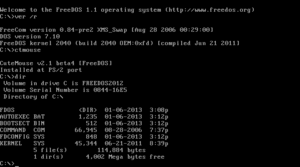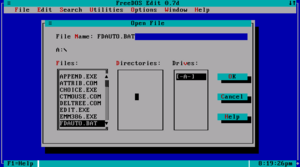FreeDOS facts for kids

FreeDOS 1.1 default shell, FreeCOM
|
|
| Company / developer | Jim Hall & The FreeDOS team |
|---|---|
| Programmed in | Assembly language, C |
| OS family | DOS |
| Working state | Current |
| Source model | Open source |
| Initial release | 16 September 1994 |
| Latest stable release | 1.4 |
| Available language(s) | English, German, Dutch, French, Turkish, Swedish, Spanish |
| Supported platforms | x86 |
| Kernel type | Monolithic kernel |
| Influenced by | MS-DOS |
| Default user interface | Command-line interface (COMMAND.COM) |
| License | GNU GPL with various different licenses for utilities |
FreeDOS is a special kind of computer program called an operating system. It's like the main brain for older IBM PC compatible computers. FreeDOS is designed to work just like MS-DOS, which was a very popular operating system a long time ago.
This system helps old computer programs run smoothly. It also supports embedded systems, which are computers built into other devices. You can start FreeDOS from a floppy disk or a USB flash drive. It also works well inside virtualization programs or x86 emulators, which let you run old computer systems on new computers.
The FreeDOS project started in 1994 with Jim Hall. The first stable version was released in 2006. Unlike most versions of MS-DOS, FreeDOS is made of free software. This means its code is open for anyone to use, change, and share. It uses the GNU General Public License. Some parts of FreeDOS also include other software that is important to keep, like 4DOS.
Contents
FreeDOS 1.1 was released on January 2, 2012. You could download it as a CD-ROM image. There was a small install disc with just the basics. There was also a full disc with many more programs, like games and tools for networking.
The older version, FreeDOS 1.0 (from 2006), came on two CDs. One was a small 8 MB CD for regular users. The other was a larger 49 MB live CD that also had the original code for the project.
Companies Using FreeDOS
Several companies use FreeDOS for different reasons:
- Dell used FreeDOS on some of its computers to make them cheaper.
- Hewlett-Packard (HP) offered FreeDOS on some of its computers, like the HP Compaq dc5750 and Mini 5101 netbooks. HP also uses FreeDOS to update the BIOS firmware on its systems.
- Steve Gibson's program, SpinRite, which helps fix hard drives, includes FreeDOS.
- Intel's tool for updating Solid-State Drive firmware uses the FreeDOS kernel.
- Many companies that make computer motherboards suggest using FreeDOS. This helps when you need to update the low-level BIOS and firmware.
Other Ways FreeDOS Is Used
FreeDOS is also part of many independent projects:
- FED-UP is a program that plays videos and can start from a floppy disk.
- FUZOMA is a FreeDOS-based system that turns old computers into learning tools for kids. It can also start from a floppy disk.
- XFDOS is a FreeDOS system that has a graphical user interface. This means it has a visual way to interact with the computer, not just text.
FreeDOS History
| Version | Status | Codename | Date |
|---|---|---|---|
| 0.01 | ALPHA | None | 16 September 1994 |
| 0.02 | ALPHA | None | December 1994 |
| 0.03 | ALPHA | None | January 1995 |
| 0.04 | ALPHA | None | June 1995 |
| 0.05 | ALPHA | None | 10 August 1996 |
| 0.06 | ALPHA | None | November 1997 |
| 0.1 | BETA | Orlando | 25 March 1998 |
| 0.2 | BETA | Marvin | 28 October 1998 |
| 0.3 | BETA | Ventura | 21 April 1999 |
| 0.4 | BETA | Lemur | 9 April 2000 |
| 0.5 | BETA | Lara | 10 August 2000 |
| 0.6 | BETA | Midnite | 18 March 2001 |
| 0.7 | BETA | Spears | 7 September 2001 |
| 0.8 | BETA | Nikita | 7 April 2002 |
| 0.9 | BETA | None | 28 September 2004 |
| 1.0 | FINAL | None | 3 September 2006 |
| 1.1 | FINAL | None | 2 January 2012 |
| 1.2 | FINAL | None | 25 December 2016 |
| 1.3 | FINAL | None | 20 February 2022 |
| 1.4 | FINAL | None | 5 April 2025 |
The FreeDOS project started on June 29, 1994. This happened after Microsoft said it would stop selling and supporting MS-DOS. Jim Hall, who was a student then, suggested creating a free version of DOS.
Soon, other programmers like Pat Villani and Tim Norman joined. They combined code they had written to create the main parts of FreeDOS. This included the kernel (the core of the operating system), the COMMAND.COM program that lets you type commands, and other basic tools. Blinky the Fish is the mascot of FreeDOS. Bas Snabilie designed him.
How FreeDOS Works with Other Systems
Computer Hardware
FreeDOS needs an older computer, like a PC/XT machine. It also needs at least 640 kilobytes of memory. Some programs that are not part of FreeDOS might need more computer resources to run.
MS-DOS and Windows Programs
FreeDOS works very much like MS-DOS. It can run different types of old programs. It also has some improvements compared to MS-DOS. These include support for newer features like different languages and better power management.
With a special tool called HX DOS Extender, FreeDOS can even run many Windows Console programs. It can also run some rare programs that have a GUI (graphical user interface), like QEMM.
Older Windows Versions
FreeDOS can run very old versions of Windows, like Microsoft Windows 1.0 and 2.0. However, it cannot fully run Windows 3.x in its advanced mode.
Newer Windows versions like Windows 95, Windows 98, and Windows Me used a simpler version of MS-DOS. FreeDOS cannot directly replace these because it doesn't have the special connections they used. But you can install FreeDOS next to these systems. You would use a special program called a boot manager to choose which system to start.
Modern Windows and ReactOS
Modern Windows systems, like Windows 2000, XP, Vista, 7, 8, 8.1, 10, and 11, do not use MS-DOS as their main part. These systems often use a different file system called NTFS.
FreeDOS can still be installed on these computers. You can put it on a separate part of the hard drive called a disk partition. Or, if the system uses the older FAT file system, you can put it on the same partition. You can even set up Windows to let you choose to start FreeDOS when the computer turns on.
Virtual Computers
FreeDOS is made to work well with programs that create "virtual computers." These include VirtualBox and VMware. Installing FreeDOS on these virtual machines is just like installing it on a real computer. You can also install FreeDOS on DOSBox, which is another type of emulator. This adds more features to the emulator.
File Systems
FreeDOS fully supports FAT32, which is a common way to organize files on a disk. This is the best format for the drive where FreeDOS starts. It can work with hard drives up to 128 GB or even 2 TB, depending on the computer's BIOS.
There is a driver called `LFNDOS` that lets FreeDOS support long file names, like those used in Windows 95. However, most older programs don't understand long file names. FreeDOS does not plan to support newer file systems like NTFS or ext2 directly. But there are other programs you can add to help with this.
See also
 In Spanish: FreeDOS para niños
In Spanish: FreeDOS para niños
- DOSBox
- DOSEMU
- DR-DOS
- ReactOS
External links
- FreeDOS on SourceForge.net
- FreeDOS Orphanage


